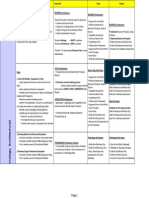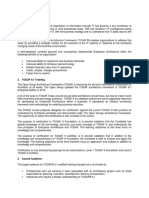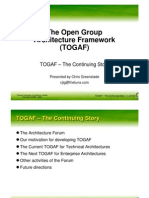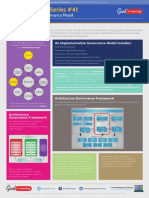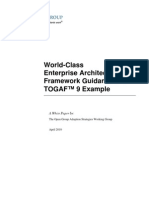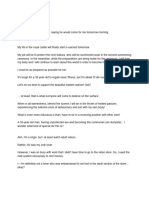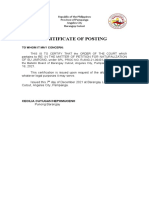100%(1)100% found this document useful (1 vote)
537 viewsTOGAF 9 Summary of Study Guide
TOGAF 9 Summary of Study Guide
Uploaded by
Juan K LunaThis document provides an overview of Juan Carlos Luna's study guide for TOGAF 9 certification. It lists the chapters covered in the guide and provides a brief summary of the content in Chapter 1, including an overview of the TOGAF certification program and topics covered on the exam. Chapter 2 is summarized as introducing basic concepts related to TOGAF such as what TOGAF is, the definition of enterprise architecture, and why enterprise architecture and frameworks are needed.
Copyright:
© All Rights Reserved
Available Formats
Download as DOCX, PDF, TXT or read online from Scribd
TOGAF 9 Summary of Study Guide
TOGAF 9 Summary of Study Guide
Uploaded by
Juan K Luna100%(1)100% found this document useful (1 vote)
537 views23 pagesThis document provides an overview of Juan Carlos Luna's study guide for TOGAF 9 certification. It lists the chapters covered in the guide and provides a brief summary of the content in Chapter 1, including an overview of the TOGAF certification program and topics covered on the exam. Chapter 2 is summarized as introducing basic concepts related to TOGAF such as what TOGAF is, the definition of enterprise architecture, and why enterprise architecture and frameworks are needed.
Copyright
© © All Rights Reserved
Available Formats
DOCX, PDF, TXT or read online from Scribd
Share this document
Did you find this document useful?
Is this content inappropriate?
This document provides an overview of Juan Carlos Luna's study guide for TOGAF 9 certification. It lists the chapters covered in the guide and provides a brief summary of the content in Chapter 1, including an overview of the TOGAF certification program and topics covered on the exam. Chapter 2 is summarized as introducing basic concepts related to TOGAF such as what TOGAF is, the definition of enterprise architecture, and why enterprise architecture and frameworks are needed.
Copyright:
© All Rights Reserved
Available Formats
Download as DOCX, PDF, TXT or read online from Scribd
Download as docx, pdf, or txt
100%(1)100% found this document useful (1 vote)
537 views23 pagesTOGAF 9 Summary of Study Guide
TOGAF 9 Summary of Study Guide
Uploaded by
Juan K LunaThis document provides an overview of Juan Carlos Luna's study guide for TOGAF 9 certification. It lists the chapters covered in the guide and provides a brief summary of the content in Chapter 1, including an overview of the TOGAF certification program and topics covered on the exam. Chapter 2 is summarized as introducing basic concepts related to TOGAF such as what TOGAF is, the definition of enterprise architecture, and why enterprise architecture and frameworks are needed.
Copyright:
© All Rights Reserved
Available Formats
Download as DOCX, PDF, TXT or read online from Scribd
Download as docx, pdf, or txt
You are on page 1of 23
At a glance
Powered by AI
The document discusses TOGAF certification, the ADM framework, and architecture governance.
TOGAF has basic concepts, core concepts, introduction to ADM, enterprise continuum and tools, ADM phases, guidelines and techniques, architecture governance, views and stakeholders, building blocks, deliverables, and reference models.
Enterprise architecture provides strategic context, more efficient operations, better investment returns, faster and cheaper procurement, and support for business strategy delivery.
TOGAF 9
Summary of Study Guide
By Juan Carlos Luna
BOOK CHAPTERS
Chapter 1. Introduction (pages 1 - 10) Ready
Chapter 2. Basic Concepts (pages 11 - 24) Ready
Chapter 3. Core Concepts (pages 25 - 40) Ready
Chapter 4. Key Terminology (pages 41 - 56) Ready
Chapter 5. Introduction to ADM (pages 57 - 74) Ready
Chapter 6. The Enterprise Continuum and Tools (pages 75 - 94) Ready
Chapter 7. The ADM Phases (pages 95 - 124) Ready
Chapter 8. ADM Guidelines and Techniques (pages 125 - 142) Ready
Chapter 9. Architecture Governance (pages 143 - 160) Pending
Chapter 10. Views, Viewpoints, and Stakeholders (pages 161 - 172) Pending
Chapter 11. Building Blocks (pages 173 - 182) Pending
Chapter 12. ADM Deliverables (pages 183 - 192) Pending
Chapter 13. TOGAF Reference Models (pages 193 - 202) Pending
CHAPTER 1. INTRODUCTION
The TOGAF 9 People certification program is a knowledge-based certification program. It has
two levels, Level 1 and Level 2, which lead to certification for TOGAF 9 Foundation and TOGAF
9 certified respectively
TOGAF certification principles:
o Openness
o Fairness
o Market Relevance
o Learning Support
o Quality
o Best Practice.
The 11 topic areas covered by the examination together with the number of questions per area in
the examination follows (for a total of 40 questions):
1) Basic concepts (3 questions)
2) Core Concepts (3 questions)
3) Introduction to the ADM (3 questions)
4) The Enterprise Continuum and Tools (4 questions)
5) ADM Phases (9 questions)
6) ADM Guidelines and Techniques (6 questions)
7) Architecture Governance (4 questions)
8) Architecture Views, Viewpoints, and Stakeholders (2 questions)
9) Building blocks (2 questions)
10) ADM Deliverables (2 questions)
11) TOGAF Reference Model (2 questions)
CHAPTER 2. BASIC CONCEPTS
What is TOGAF?
TOGAF is an architecture framework (The Open Group Architecture Framework). It is a tool for
assisting in acceptance, production, use and maintenance of enterprise architectures. It is based
on an iterative process model supported by best practices and a re-usable set of existing
architectural assets.
Structure of TOGAF document:
What is an enterprise?
It is any collection of organizations that has a common set of goals. It can be an entire enterprise,
or a specific domain within the enterprise.
What is enterprise architecture?
The organizing logic for business processes and IT infrastructure reflecting the integration and
standardization requirements of the operational model [MIT].
A conceptual blueprint that defines the structure and operation of an organization
[SearchCIO.com].
Why do I need enterprise architecture? What are the business benefits?
The purpose of enterprise architecture is to optimize across the enterprise the often fragmented
legacy of processes (both manual and automated) into an integrated environment that is
responsive to change and supportive of the delivery of the business strategy.
Enterprise architecture provides a strategic context for the evolution of the IT System in response
to the constantly changing needs of business environment.
What are the business benefits of having enterprise architecture?
o More efficient IT operation.
o Better return of existing investment, reduced risk for future investment.
o Faster, simpler, and cheaper procurement.
What is architecture in the context of TOGAF?
In TOGAF, architecture has two meanings depending upon the context:
a) A formal description of a system, or a detailed plan of the system at a component level to
guide its implementation.
b) The structure of components, their inter-relationships, and the principles and guidelines
governing their design and evolution over time.
What is an architecture framework?
It is a tool for developing a broad range of different architectures. It should describe a method (for
designing an information system in terms of building blocks), and contain a set of tools as well as
provide a common vocabulary.
Why do I need a framework for enterprise architecture?
By using an Enterprise Architecture, we can:
o Speed up and simplify architecture development
o Ensure more complete coverage of the designed solution
o Ensure that the architecture allows for future growth in response to needs of business.
Why is TOGAF suitable as a framework for enterprise architecture?
Because 1) TOGAF has been developed through the collaborative efforts of more than 300
Architecture Forum member companies from some of the worlds leading IT customers and
vendors; 2) Enable users to build open systems-based solutions; 3) Using TOGAF will allow
architectures to be developed consistently, reflecting the needs of stakeholders, and employing
best practice.
What are the different types of architecture that TOGAF deals with?
What does TOGAF contain?
CHAPTER 3. CORE CONCEPTS
TOGAF Architecture Content Framework is a structural model in which to place work products. It
uses three categories to describe the type of architectural work product:
Deliverable: a work product that is contractually specified and in turn formally reviewed, agreed,
and signed off by the stakeholders.
Artifact: describes architecture from a specific viewpoint. They are generally classified as catalogs,
matrices and diagrams. Artifacts will form the content of the Architecture Repository.
Building block: represents a potentially re-usable component of business, IT, or architectural
capability that can be combined with other building blocks to deliver architectures and solutions.
What are the Phases of the ADM?
Whats The Enterprise Continuum?
The Enterprise Continuum is a view of the Architecture Repository that provides methods for
classifying architecture and solution artifacts as they evolve from generic Foundation Architectures
to Organization-Specific Architectures.
Whats The Architecture Repository?
The Architecture Repository stores different classes of architectural output at different levels of
abstraction, created by the ADM.
The major components within an Architecture Repository are: The Architecture Meta-model, The
Architecture Capability, The Architecture Landscape (view of the building blocks in use in the
organization today), The Standards Information Base (SIB), The Reference Library (reference
material), and The Governance Log (records governance activity across the enterprise).
The concept of establishing and maintaining an Enterprise Architecture Capability
TOGAF 9 provides an Architecture Capability Framework that is a set of reference material and
guidelines for establishing an architecture function or capability within an organization.
The concept of establishing an Operational Architecture Capability as an Operational Entity
An enterprise architecture practice should be treated like a business. An enterprise architecture
practice should establish capabilities in: Financial Mgt., Performance Mgt., Service Mgt., Risk Mgt.,
Resource Mgt., Communications and Stakeholder Mgt., Quality Mgt., Supplier Mgt., Configuration
Mgt., Environment Mgt.
Central to the notion of operating an ongoing architecture is the execution of well-defined and
effective governance Architecture Governance whereby all architecturally significant activity is
controlled and aligned within a single framework.
Using TOGAF with other Frameworks
TOGAF provides a flexible and extensible content framework that underpins a set of generic
architecture deliverable. As a result, TOGAF may be used either in its own right, with the generic
deliverable that it describes; or else these deliverables may be replaced or extended by a more
specific set, defined in any other framework that the architect considers relevant. What it is
required in all cases, is to adapt and build on the TOGAF framework in order to define a tailored
method that is integrated into the processes and (organization) structures of the enterprise.
It is valid to adapt TOGAF methods with other standard frameworks, such as ITIL, CMMI, COBIT,
PRINCE2, PMBOK, and MSP.
The TOGAF Document Categorization Model
Its a model intended to assist with the release management of specification content.
CHAPTER 4. KEY TERMINOLOGY
Term Description
Activity A task or collection of tasks that support the functions of an organization.
Application A deployed and operational IT system that supports business functions and services.
Application Architecture A description of the major logical grouping of capabilities that manage the data objects
necessary to process the data and support the business
Architecture Two meanings: a) formal description of a system (or a detailed plan of the system at
component level to guide its implementation); b) The structure of components, their
inter-relationships, and the principles and guidelines governing their design and
evolution over time.
Architecture Continuum A repository of architectural elements with increasing detail and specialization.
Architecture Building Block
(ABB)
A constituent of the architecture model that describes a single aspect of the overall
model
Architecture Development
Method
The core of TOGAF. A step-by-step approach to develop and use an enterprise
architecture.
Architecture Domain The architectural area being considered. There are four architecture domains within
TOGAF: Business, Data, Application, and Technology.
Architecture Framework A foundational structure or set of structures, which can be used for developing a broad
range of different architectures.
Architecture Principles A qualitative statement of intent that should be met by the architecture. Has at least a
supporting rationale and a measure of importance.
Architecture View See View definition
Architecture Vision Three definitions: 1) A high-level, aspirational view of the Target Architecture. 2) A
phase in the ADM which delivers understanding and definition of the Architecture
Vision. 3) A specific deliverable describing the Architecture Vision.
Baseline A specification that has been formally reviewed and agreed upon, that thereafter serves
as the basis for further development or change and that can be changed only through
formal change control procedures or a type of procedure such as configuration
management.
Baseline Architecture The existing defined system architecture before entering a cycle of architecture review
and redesign.
Building Block Represents a (potentially re-usable) component of business, IT, or architectural
capability that can be combined with other building blocks to deliver architectures and
solutions.
Business Architecture The business strategy, governance, organization, and key business processes
information, as well as the interaction between these concepts.
Business Governance Concerned with ensuring that the business processes and policies (and their operation)
deliver the business outcomes and adhere to relevant business regulation.
Capability An ability that an organization, person, or system possesses.
Concerns The key interests that are crucially important to the stakeholders in a system, and
determine the acceptability of the system.
Constraint An external factor that prevents an organization from pursuing particular approaches to
meet its goals.
Data Architecture The structure of an organizations logical and physical data assets and data management
resources.
Deliverable An architectural work product that is contractually specified and in turn formally
reviewed, agreed, and signed off by the stakeholders.
Enterprise The highest level (typically) of description of an organization and typically covers all
missions and functions. An enterprise will often span multiple organizations.
Enterprise Continuum A categorization mechanism useful for classifying architecture and solution artifacts,
both internal and external to the Architecture Repository, as they evolve from generic
Foundation Architectures to Organization-Specific Architectures.
Foundation Architecture An architecture of generic services and functions that provides a foundation on which
more specific architectures and architectural components can be built.
Gap A statement of difference between two states. Used in the context of gap analysis, where
Term Description
the difference between the Baseline and Target Architecture is identified.
Governance The discipline of monitoring, managing, and steering a business (or IS/IT landscape) to
deliver the business outcome required.
Information Any communication or representation of facts, data, or opinions, in any medium or form,
including textual, numerical, graphic, cartographic, narrative, or audio-visual.
Information Technology (IT) 1) The lifecycle management of information and related technology used by an
organization; 2) An umbrella term that includes all or some of the subject areas relating
to the computer industry; 3) a department within an organization tasked with
provisioning some or all of the domains described before; 4) Alternate names commonly
adopted include Information Services, Information Management, etc
Metadata Data about data, of any sort in any media that describes the characteristics of an entity.
Metamodel A model that describes how and with what the architecture will be described in a
structured way.
Method A defined, repeatable approach to address a particular type of problem.
Methodology A defined, repeatable series of steps to address a particular type of problem, which
typically centers on a defined process, but may also include definition of content.
Model A representation of a subject of interest. A model provides a smaller scale, simplified,
and/or abstract representation of the subject matter.
Modeling A technique through construction of models which enables a subject to be represented in
a form that enables reasoning, insight, and clarity concerning the essence of the subject
matter
Objective A time-bounded milestone for an organization used to demonstrate progress towards a
goal.
Physical A description of a real-world entity.
Reference Model A reference model is an abstract framework for understanding significant relationships
among the entities of [an] environment, and for the development of consistent standards
or specifications supporting that environment.
Repository A system that manages all of the data of an enterprise, including data and process models
and other enterprise information.
Requirement A quantitative statement of business need that must be met by a particular architecture or
work package.
Segment Architecture A detailed, formal description of areas within an enterprise, used at the program or
portfolio level to organize and align change activity.
Solution Architecture A description of a discrete and focused business operation or activity and how IS/IT
supports that operation.
Solution Building Block A candidate physical solution for an Architecture Building Block (ABB).
Solutions Continuum A repository of re-usable solutions for future implementation efforts.
Stakeholder An individual, team, or organization (or classes thereof) with interests in, or concerns
relative to, the outcome of the architecture.
Strategic Architecture A summary formal description of the enterprise, providing an organizing framework for
operational and change activity, and an executive-level, long-term view for direction
setting.
Target Architecture The description of a future state of the architecture being developed for an organization.
Technical Reference Model
(TRM)
A structure which allows the components of an information system to be described in a
consistent manner.
Technology Architecture The logical software and hardware capabilities that are required to support deployment
of business, data, and application services.
Transition Architecture A formal description of the enterprise architecture showing periods of transition and
development for particular parts of the enterprise.
View The representation of a related set of concerns.
Viewpoint A definition of the perspective from which a view is taken.
CHAPTER 5. INTRODUCTION TO THE ARCHITECTURE DEVELOPMENT
METHOD (ADM)
The TOGAF ADM is a comprehensive general method.
It defines a recommended sequence for the various phases and steps involved in developing
an architecture. It is an iterative method.
A number of inputs and outputs are recommended for each phase.
It draws on other parts of TOGAF for assets and processes.
The ADM can be used with other deliverables from other frameworks.
The ADM does not recommend a scope; this has to be determined by the organization itself.
The choice of scope is critical to the success of the architecting effort. The main guideline is to
focus on what creates value to the enterprise, and to select horizontal and vertical scope, and
project schedules, accordingly. This exercise will be repeated, and future iterations will build
on what is being created in the current effort, adding greater width and depth.
Where necessary, use of the ADM should be tailored to meet the needs of the organization.
This means that some phases may be omitted, modified, or even additional procedures added.
CHAPTER 6. THE ENTERPRISE CONTINUUM AND TOOLS
The Enterprise Continuum is a virtual repository for architecture assets both internal and external
to the enterprise. It can be thought of as a view of the Architecture Repository. It enables the
classification of re-usable architecture and solution assets. It is also an aid to communication
between all architects involved in building and procuring an architecture by providing a common
language and terminology. This, in turn, enables efficiency in engineering and effective use of
COTS products.
The Architecture Continuum is part of an organizations Enterprise Continuum and is supported by
the Solutions Continuum. It offers a consistent way to define and understand the generic rules,
representations, and relationships in an information system, and it represents a conceptual
structuring of re-usable architecture assets.
The Architecture Continuum shows the relationships among foundational frameworks (such as the
TOGAF Foundation Architecture), Common Systems Architectures (such as the III-RM), Industry
Architectures, and Organization-Specific Architectures. It is also a useful tool to discover
commonality and eliminate unnecessary redundancy.
The Solutions Continuum is part of an organizations Enterprise Continuum. It represents
implementations of the architectures at the corresponding levels of the Architecture Continuum.
At each level, the Solutions Continuum is a population of the architecture with reference building
blocks either purchased products or built components that represent a solution to the
enterprises business needs.
The Architecture Repository provides a structural framework for a physical repository for
managing architectural work products and is a model of a physical instance of the Enterprise
Continuum. The Architecture Repository defines six classes for architectural information held in
the repository.
TOGAF recognizes the need to manage the content of the Enterprise Continuum using tools, and
includes guidance on tool selection, including a set of evaluation criteria to aid selection of tools.
CHAPTER 7. THE ADM PHASES
Preliminary Phase
It prepares an organization to undertake successful enterprise architecture projects.
There are seven aspects of the approach undertaken in the Preliminary Phase:
1. Defining the enterprise
2. Identifying key drivers and elements in the organizational context.
3. Defining the requirements for architecture work.
4. Defining the architecture principles that will inform any architecture work
5. Defining the framework to be used
6. Defining the relationships between management frameworks
7. Evaluating the enterprise architectures maturity
Phase A. Architecture Vision
It is about project establishment and initiates iteration on the Architecture Development Cycle,
setting the scope, constraints, and expectations for the iteration. It is required at the start of
every architecture cycle.
Two main aspects of the approach for the Phase A:
Creating the Architecture Vision
Business Scenarios
CHAPTER 8. ADM GUIDELINES AND TECHNIQUES (TOGAF PART III)
The guidelines document how to adapt the ADM process.
Techniques are used when applying the ADM process.
8.1. Architecture Principle
Architecture principles are a set of general rules and guidelines for the architecture being
developed. Principles are an initial output of the Preliminary Phase.
Principles may be established at any or all of three levels:
1. Enterprise principles
2. IT principles
3. Architecture principles (subset of IT principles). It can be further divided into a) principles
that govern the architecture process, and b) principles that govern the implementation of
the architecture.
8.2. TOGAF Template for Defining Principles
TOGAF template defines next sections:
Name, Statement
Rationale: Should highlight the business benefits of adhering to the principle, using business
terminology.
Implications
What Makes a Good Architecture Principle?
Five criteria distinguish a good set of principles: understandability, robustness, completeness,
consistency and stability.
8.3. Business Scenarios
Its a technique used to help identify and understand the business requirements that architecture
must address.
A business scenario describes:
A business process, application, or set of applications
The business and technology environment
The people and computing components (actors) who execute the scenario
The desired outcome of proper execution
A good business scenario is SMART (Specific, Measurable, Actionable, Realistic, Time-bound).
Where business scenarios are used within the ADM cycle?
Most prominently in the initial phase, Architecture Vision (to define relevant business
requirements, and to build consensus with business management and other stakeholders).
However, they may also be used in other phases, particularly Business Architecture (to derive the
characteristics of the architecture directly from the high-level requirements of business).
8.3. GAP ANALYSIS
Whats the purpose of the technique known as Gap Analysis?
The basic premise is to highlight a shortfall between the Baseline Architecture and the Target
Architecture; that is, items that have been deliberately omitted, accidentally left out, or not yet
defined.
Example:
Gap analysis technique should be used in phases B, C, D and E.
8.4. INTEROPERABILITY
TOGAF Definition: The ability to share information and services.
Interoperability categorization:
Operational or Business interoperability: defines how business processes are to be shared.
Information interoperability: defines how information is to be shared.
Technical interoperability: defines how technical services are to be shared (or connect to
one another).
Interoperability categorization from IT perspective:
Presentation/Information/Application/Technical interoperability.
Interoperability requirements are used within the ADM in following phases: A to F phases.
8.5. Business Transformation Readiness Assessment
BTRA provides a technique for understanding the readiness of an organization to accept change,
identifying the issues and dealing with them in the implementation and Migration plan.
Use of such a technique is key to a successful architecture transformation in Phases E and F. An
initial assessment of business transformation readiness is carried out in Phase A.
8.6. RISK MANAGEMENT
Its a technique used to mitigate risk when implementing an architecture project. There are two
level of risk that should be considered:
Initial Level of Risk Prior to determining and implementing mitigating actions.
Residual Level of Risk After implementation of mitigating actions.
The recommended process for managing risk consists of the following activities:
Risk classification
Risk identification
Initial risk assessment
Risk mitigation and residual risk assessment
Risk monitoring
8.7. CAPABILITY-BASED PLANNING
Capability-based planning is a versatile business planning paradigm that is very useful from an
enterprise architecture perspective. It assists in aligning IT with the business and helps focus IT
architects on the continuous creation of business value.
CHAPTER 9. ARCHITECTURE GOVERNANCE
Architecture Governance is the practice and orientation by which enterprise architectures and
other architectures are managed and controlled at an enterprise-wide level. Architecture
Governance covers the management and control of all aspects of the development and evolution
of architectures. It needs to be supported by an Architecture Governance Framework which
assists in identifying effective processes so that the business responsibilities associated with
Architecture Governance can be elucidated, communicated, and managed effectively. TOGAF
provides such a framework.
Levels of Governance within the Enterprise
Corporate governance
Technology governance
IT governance
Architecture governance
Characteristics of Governance
Discipline
Transparency
Independence
Accountability
Responsibility
Fairness
Architecture Governance Framework
Conceptual Structure
Organizational Structure
An effective Architecture Governance structure requires processes, structures, and capabilities
and will typically include a global governance board, local governance board, design authorities,
and working parties.
Key Areas
Key areas of architecture management: Develop, Implement, and Deploy.
Architecture Board
An important element in any Architecture Governance strategy is establishment of a cross-
organizational Architecture Board to oversee the implementation of the governance strategy. This
body should be representative of all the key stakeholders in the architecture, and will typically
comprise a group of executives responsible for the review and maintenance of the overall
architecture.
List the responsibilities of an Architecture Board
Consistency between sub-architectures
Identifying re-usable components
Flexibility of enterprise architecture
Enforcement of Architecture Compliance
Improving the maturity level or architecture discipline within the organization
Ensuring that the discipline of architecture-based development is adopted
Providing the basis for all decision-making with regard to changes to the architectures
Supporting a visible escalation capability for out-of-bounds decisions
Architecture Contracts
Architecture Contracts are joint agreements between development partners and sponsors on the
deliverables, quality, and fitness-for-purpose of an architecture. Successful implementation of
these agreements will be delivered through effective Architecture Governance.
Architecture Compliance
The need for Architecture Compliance
Ensuring the compliance of individual projects within the enterprise architecture is an essential
aspect of Architecture Governance. An Architecture Compliance strategy should be adopted.
TOGAF recommends two complementary processes: The Architecture function and the IT
Governance function.
The Purpose of Architecture Compliance Reviews
To catch errors in the project architecture early
To ensure the application of best practices to architecture work
To identify where the standards themselves may require modification
To identify services that are currently application-specific but might be provided as part of
the enterprise infrastructure
To provide an overview of the compliance of an architecture to mandated enterprise
standards
To document strategies for collaboration, resource sharing, and other synergies across
multiple architecture teams
To take advantage of advances in technology
To communicate to management the status of technical readiness of the project
To identify key criteria for procurement activities
To identify and communicate significant architectural gaps to product and service
providers
The Architecture Compliance Review Process
An Architecture Compliance Review is a scrutiny of the compliance of a specific project against
established architectural criteria, spirit, and business objectives.
You might also like
- The Practice of Enterprise Architecture: A Modern Approach to Business and IT AlignmentFrom EverandThe Practice of Enterprise Architecture: A Modern Approach to Business and IT AlignmentRating: 4 out of 5 stars4/5 (1)
- My Notes For TOGAF CertificationDocument15 pagesMy Notes For TOGAF CertificationsmithsinghNo ratings yet
- Togaf 9 1 Cheat Sheet v0 2Document13 pagesTogaf 9 1 Cheat Sheet v0 2Arghya Mukherjee67% (3)
- Enterprise Architecture For Dummies-Togaf9Document55 pagesEnterprise Architecture For Dummies-Togaf9srinivaskannan100% (3)
- STAD01Document87 pagesSTAD01Aggelos Kotsokolos100% (1)
- TOGAF 9 Template - Architecture DefinitionDocument70 pagesTOGAF 9 Template - Architecture DefinitionAhmadNo ratings yet
- TOGAF 9 Combined Part 1 and Part 2Document84 pagesTOGAF 9 Combined Part 1 and Part 2MbaStudent56100% (3)
- TOGAF® 9 Certification Self-Study Pack, 3rd Edition - B097Document2 pagesTOGAF® 9 Certification Self-Study Pack, 3rd Edition - B097julio prestan0% (2)
- My Own Togaf NotesDocument87 pagesMy Own Togaf NotesEdwin Chan86% (7)
- TOGAF9 - CheatSheet - Part II PDFDocument9 pagesTOGAF9 - CheatSheet - Part II PDFMohan KumaresanNo ratings yet
- Free OG0-093 Exam Prep The Open Group Realtests Mar-2016 by HazelDocument26 pagesFree OG0-093 Exam Prep The Open Group Realtests Mar-2016 by HazelNisheeth RanjanNo ratings yet
- Exam Dumps 2018Document7 pagesExam Dumps 2018mike100% (1)
- Togaf in PicturesDocument34 pagesTogaf in Picturesnewelljj100% (9)
- Enterprise Architecture Body Of Knowledge A Complete Guide - 2021 EditionFrom EverandEnterprise Architecture Body Of Knowledge A Complete Guide - 2021 EditionNo ratings yet
- California AflameDocument77 pagesCalifornia AflameShane K Pule Sr.No ratings yet
- Togaf QSDocument79 pagesTogaf QSanarki85100% (1)
- Togaf9 TestDocument101 pagesTogaf9 Testbprakash16No ratings yet
- Togaf 9 NotesDocument18 pagesTogaf 9 Notesmohammedomar1974No ratings yet
- TogafDocument28 pagesTogafDahlia Gamal67% (3)
- TOGAF 9 and Archimate 2.0 For Aligning SOA With Business Strategies and CapabilitiesDocument44 pagesTOGAF 9 and Archimate 2.0 For Aligning SOA With Business Strategies and CapabilitiesArgha RahaNo ratings yet
- Togaf 10 IntroDocument71 pagesTogaf 10 IntroAntwan Bell100% (4)
- TOGAF 9.1 - Course ContentDocument5 pagesTOGAF 9.1 - Course ContentSiddharth PareekNo ratings yet
- TOGAF ExplainedDocument6 pagesTOGAF ExplainedHimanshuNo ratings yet
- The Architecture Development Method: Personal PDF EditionDocument18 pagesThe Architecture Development Method: Personal PDF Editionkumar100% (1)
- TOGAF 9 ADM Reference Card Phases N093Document12 pagesTOGAF 9 ADM Reference Card Phases N093kamilprasilNo ratings yet
- Togaf 9 Multiple Choice QuestionsDocument12 pagesTogaf 9 Multiple Choice Questionsv9pratap100% (2)
- Togaf Book QuestionsDocument14 pagesTogaf Book Questionss_mullickNo ratings yet
- TOGAF V92 Part1Document104 pagesTOGAF V92 Part1rammohan thirupasur100% (1)
- TogafDocument16 pagesTogafHemant ShindeNo ratings yet
- Togaf by Open GroupDocument26 pagesTogaf by Open GroupPablo Book100% (2)
- Togaf 91 in Pictures 2Document13 pagesTogaf 91 in Pictures 2samya222100% (2)
- Introduction To Enterprise Architecture and TOGAF 9.1 PDFDocument63 pagesIntroduction To Enterprise Architecture and TOGAF 9.1 PDFcarloscruz1100% (2)
- TOGAF 9 Template - Architecture DefinitionDocument70 pagesTOGAF 9 Template - Architecture DefinitionzzoraineNo ratings yet
- TOGAF 9 Part 1 Foundation Level E-Learning WorkbookDocument54 pagesTOGAF 9 Part 1 Foundation Level E-Learning Workbookdennitoz67% (3)
- Togaf 9 Scenario QuestionsDocument5 pagesTogaf 9 Scenario QuestionsdineshkaushalNo ratings yet
- GoodElearning TOGAF Poster 50 - Architectural ArtifactsDocument1 pageGoodElearning TOGAF Poster 50 - Architectural ArtifactsFabian HidalgoNo ratings yet
- Clearing TOGAF 9 Level 1 and Level 2 Certification Exam PDFDocument4 pagesClearing TOGAF 9 Level 1 and Level 2 Certification Exam PDFshekhar785424No ratings yet
- Clearing TOGAF 9 Level 1 and Level 2 Certification ExamDocument4 pagesClearing TOGAF 9 Level 1 and Level 2 Certification ExamfrancoisadtNo ratings yet
- TGF Qset 1 Asm 1 - QuestionsDocument7 pagesTGF Qset 1 Asm 1 - Questionssatyajit mohantyNo ratings yet
- Togaf 9 Foundation Exam Study GuideDocument3 pagesTogaf 9 Foundation Exam Study Guideswapnil_bankarNo ratings yet
- TOGAF - PresentationDocument102 pagesTOGAF - PresentationLuis YañezNo ratings yet
- GoodElearning TOGAF Poster 46 - Adapting The ADMDocument1 pageGoodElearning TOGAF Poster 46 - Adapting The ADMFabian HidalgoNo ratings yet
- Practical TOGAF 9 Sample Soln 2014Q2Document35 pagesPractical TOGAF 9 Sample Soln 2014Q2HPot PotTechNo ratings yet
- OG0 093 Exam Dumps 2018 PDFDocument7 pagesOG0 093 Exam Dumps 2018 PDFsaragadamsivakumarNo ratings yet
- TOGAF 9 Part 1Document61 pagesTOGAF 9 Part 1MbaStudent56No ratings yet
- GoodElearning TOGAF Poster 41 - 150DPIDocument1 pageGoodElearning TOGAF Poster 41 - 150DPIFabian HidalgoNo ratings yet
- TOGAF 9 Template - Architecture DefinitionDocument90 pagesTOGAF 9 Template - Architecture DefinitionMateri SmaNo ratings yet
- Enterprise Architecture - Framework Guidance and TOGAF ExampleDocument32 pagesEnterprise Architecture - Framework Guidance and TOGAF Examplesudha_gangaNo ratings yet
- 2 Introduction TOGAF and Phase Requirements ManagementDocument81 pages2 Introduction TOGAF and Phase Requirements ManagementSILVERNo ratings yet
- Togaf Short QuestionsDocument24 pagesTogaf Short QuestionssomenathbasakNo ratings yet
- Togaf 9 Exam Study GuideDocument5 pagesTogaf 9 Exam Study Guidegringola61830% (1)
- Enterprise Architects: The Agents of Digital TransformationFrom EverandEnterprise Architects: The Agents of Digital TransformationNo ratings yet
- Enterprise Architecture Tools A Complete Guide - 2021 EditionFrom EverandEnterprise Architecture Tools A Complete Guide - 2021 EditionRating: 5 out of 5 stars5/5 (1)
- SuhUPuUIEemXzg7gMaRPpg EA. Lecture 2. TogafDocument11 pagesSuhUPuUIEemXzg7gMaRPpg EA. Lecture 2. TogafSami MahmoudNo ratings yet
- Resume Togaf 9.2Document7 pagesResume Togaf 9.2irham fuadiNo ratings yet
- ScriedriebrochureDocument32 pagesScriedriebrochureapi-317156030No ratings yet
- Bse Common Booklet On Securities MarketDocument42 pagesBse Common Booklet On Securities MarketELO OPSNo ratings yet
- Dogs in The District: DC Parks and RecreationDocument2 pagesDogs in The District: DC Parks and RecreationWUSA9-TVNo ratings yet
- Data Mining FOR Business Intelligence (1 and 2)Document28 pagesData Mining FOR Business Intelligence (1 and 2)ayodhyapNo ratings yet
- Top Ten Antivirus 2012Document9 pagesTop Ten Antivirus 2012pnaronaNo ratings yet
- Madhya Pradesh Jan Shiksha Adhiniyam, 2002Document21 pagesMadhya Pradesh Jan Shiksha Adhiniyam, 2002Latest Laws TeamNo ratings yet
- Comparison Between Chinese Literature "Jin Ping Mei and Japanese Literature The Tale ofDocument7 pagesComparison Between Chinese Literature "Jin Ping Mei and Japanese Literature The Tale ofAssignmentLab.comNo ratings yet
- Self Concept in Consumer BehaviourDocument20 pagesSelf Concept in Consumer BehaviourgreatisacNo ratings yet
- G.R.-No.-224679-police PowerDocument12 pagesG.R.-No.-224679-police PowerCyborg FrankyNo ratings yet
- Seduction Strategy 13 (NSFW)Document6 pagesSeduction Strategy 13 (NSFW)namjoonleftoenailNo ratings yet
- Subhamsharaffflipkart 190214071150Document51 pagesSubhamsharaffflipkart 190214071150manoj kumar DasNo ratings yet
- Slides Tan (2017) - AFA - 3e - PPT - Chap06Document51 pagesSlides Tan (2017) - AFA - 3e - PPT - Chap06Uyên Phạm PhươngNo ratings yet
- The Mansions of The Moon V1Document14 pagesThe Mansions of The Moon V1Hasanthi KingsleyNo ratings yet
- Spiritual Practice, by Swami AshokanandaDocument46 pagesSpiritual Practice, by Swami AshokanandaEstudante da Vedanta100% (1)
- Yakshagana and Modern TheatreDocument10 pagesYakshagana and Modern Theatreswamimanohar100% (4)
- The World Coffee Museum in Dak Lak ProvinceDocument3 pagesThe World Coffee Museum in Dak Lak ProvinceTrần Phương NgânNo ratings yet
- ClientAgreement 7121000019 28 10 2021Document4 pagesClientAgreement 7121000019 28 10 2021Karthik KarthikNo ratings yet
- RWS ExamDocument3 pagesRWS ExamYAMILA NATASHA SURLANo ratings yet
- Ancient Egyptian and Egyptological Attitudes Towards CatsDocument21 pagesAncient Egyptian and Egyptological Attitudes Towards CatsMeilin Lu100% (1)
- What Is A Healthcare Marketing PlanDocument15 pagesWhat Is A Healthcare Marketing Planavijitcu2007No ratings yet
- Poets and PancakesDocument4 pagesPoets and PancakesKrishikaNo ratings yet
- Posting SampleDocument5 pagesPosting SamplemkabNo ratings yet
- Teenagers FoodDocument3 pagesTeenagers FoodRohit BiswasNo ratings yet
- Commercial Real Estate Investment Funding ProposalDocument8 pagesCommercial Real Estate Investment Funding ProposalwaaaNo ratings yet
- City of Pasig Vs Republic - CDDocument2 pagesCity of Pasig Vs Republic - CDNolas JayNo ratings yet
- Website Visit-IncDocument19 pagesWebsite Visit-IncRamya SriNo ratings yet
- CEI Planet Winter 2020Document16 pagesCEI Planet Winter 2020CEINo ratings yet
- Material Approval Request: Listed ProposedDocument2 pagesMaterial Approval Request: Listed Proposedg3neps100% (3)









